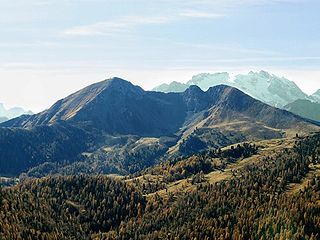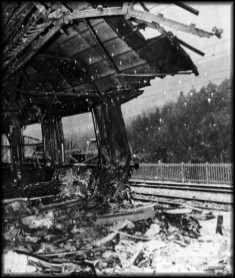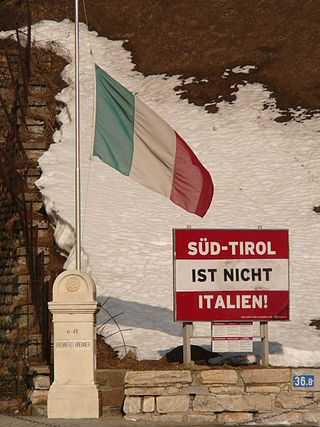
Ladin is a Romance language of the Rhaeto-Romance subgroup, mainly spoken in the Dolomite Mountains in Northern Italy in the provinces of South Tyrol, Trentino, and Belluno, by the Ladin people. It exhibits similarities to Romansh, spoken in Switzerland, as well as Friulian, spoken in north-east Italy.

Sepp Kerschbaumer was a leading member of the South Tyrolean Liberation Committee (Befreiungsausschuss Südtirol ), which campaigned for the break-away of South Tyrol from Italy. In 1961, the BAS staged the so-called Feuernacht, the destruction of several dozen electricity pylons, which escalated the South Tyrol conflict. The Italian state viewed the BAS as a terrorist and separatist organization, while large parts of the South Tyroleans regarded them as freedom fighters.

The province of Belluno is a province in the Veneto region of Italy. Its capital is the city of Belluno.

The German Night Gate Fire happened on the night of 12 June 1961 when 37 electricity pylons were blown up in South Tyrol by the South Tyrolean Liberation Committee. It formed a turning point in the history of the province.
The Kreuzbergpass (1636 m) is a high mountain pass between the provinces of South Tyrol and Belluno in Italy. It connects the Puster Valley with Cadore.

The Tre Cime di Lavaredo, also called the Drei Zinnen ; pronounced[ˌdʁaɪˈtsɪnən] ), are three distinctive battlement-like peaks, in the Sexten Dolomites of northeastern Italy. They are one of the best-known mountain groups in the Alps. The three peaks, from east to west, are:

The Alpine Brigade "Cadore" was a light Infantry brigade of the Italian Army, specializing in mountain warfare. Its core units were Alpini, the mountain infantry corps of the Italian Army, that distinguished itself in combat during World War I and World War II. The brigade was based in the Italian provinces of Belluno and Vicenza with its headquarters Belluno. The brigade was disbanded in 1997.

The 12th Alpini Regiment is an inactive mountain warfare regiment of the Italian Army last based in Pieve di Cadore in Veneto. The regiment belongs to the Italian Army's Alpini infantry speciality and was assigned to the Alpine Brigade "Cadore". The regiment was formed in 1992 and consisted of the Alpini Battalion "Pieve di Cadore", whose flag and traditions it inherited.

The 16th Regiment "Belluno" is an inactive mountain warfare regiment of the Italian Army last based in Belluno in Veneto. The regiment belongs to the Italian Army's Alpini infantry speciality and was a training unit last assigned to the Alpine Troops Command. The regiment was formed in 1991 and consisted of the Alpini Battalion "Belluno", whose flag and traditions it inherited.

The Comando Truppe Alpine or COMTA commands the Mountain Troops of the Italian Army, called Alpini and various support and training units. It is the successor to the 4º Corpo d'Armata Alpino of the Cold War. The Alpini are light Infantry units specializing in Mountain Combat. The subordinate units of the COMTA distinguished themselves during combat in World War I and World War II.
The South Tyrolean Liberation Committee was an underground secessionist and terrorist organisation founded by Sepp Kerschbaumer and several combatants including Georg Klotz in the mid-1950s which aimed to achieve the right for self-determination for South Tyrol and the related secession from Italy via bomb attacks.

The Col di Lana is a mountain of the Fanes Group in the Italian Dolomites. The actual peak is called Cima Lana and situated in the municipality of Livinallongo del Col di Lana in the Province of Belluno, Veneto region.
On March 1, 1984 the Italian Institute for Disarmament, Development and Peace (Istituto di ricerche per il disarmo, lo sviluppo e la pace in Rome published the entire Italian Army order of battle down to company level – this was justified by the radical party as one of its core demands was total disarmament of Europe, even though the data which was published was top secret. The Radical Party dissolved in 1989 and the IRDISP followed suit in 1990. But Radio Radicale has survived, and the OrBat can still be found today on the homepage of the radio.

In 1919, at the time of its annexation, the middle part of the County of Tyrol which is today called South Tyrol was inhabited by almost 90% German speakers. Under the 1939 South Tyrol Option Agreement, Adolf Hitler and Benito Mussolini determined the status of the German and Ladin (Rhaeto-Romanic) ethnic groups living in the region. They could emigrate to Germany, or stay in Italy and accept their complete Italianization. As a consequence of this, the society of South Tyrol was deeply riven. Those who wanted to stay, the so-called Dableiber, were condemned as traitors while those who left (Optanten) were defamed as Nazis. Because of the outbreak of World War II, this agreement was never fully implemented. Illegal Katakombenschulen were set up to teach children the German language.

Salvatore Riina, called Totò, was an Italian mobster and chief of the Sicilian Mafia, known for a ruthless murder campaign that reached a peak in the early 1990s with the assassinations of Antimafia Commission prosecutors Giovanni Falcone and Paolo Borsellino, resulting in widespread public outcry, legal change and a major crackdown by the authorities. He was also known by the nicknames la belva and il capo dei capi.

The Train 904 bombing was a terror attack which occurred on 23 December 1984, in the Apennine Base Tunnel. A bomb on the 904 express train from Naples to Milan was detonated, killing 16 and wounding 266. The bombing location was near the location of the Italicus Express bombing ten years previously.

The South Tyrolean independence movement is a political movement in the Italian autonomous province of South Tyrol that calls for the secession of the region from Italy and its reunification with the State of Tyrol, Austria. Concurrently, some groups favor the establishment of an interim Free State of South Tyrol as a sovereign nation while reintegration is organized.

Terrorism in Italy is related to political and subversive terrorism activities, carried out by various groups and organizations with different and sometimes conflicting methods, motivations and interests. This article is primarily about late 20th-century and early 21st-century terrorism.
The Malga Sasso bombing was a major bomb attack on an Italian Guardia di Finanza outpost not far from the Brennero pass, in the Province of Bolzano, near the border with Austria. The attack was carried out on 9 September 1966 by members of the South Tyrolean Liberation Committee (BAS), a paramilitary organization seeking the independence of German-speaking South Tyrol from Italy. Two guards were killed by the blast on the spot, while a third died of wounds several days later. Three others were seriously injured. The separatist militants Alois Larch, Alois Rainer and Richard Kofler were prosecuted and sentenced by the Italian Justice in 1976.

The White War is the name given to the fighting in the high-altitude Alpine sector of the Italian front during the First World War, principally in the Dolomites, the Ortles-Cevedale Alps and the Adamello-Presanella Alps. More than two-thirds of this conflict zone lies at an altitude above 2,000m, rising to 3905m at Mount Ortler. In 1917 New York World correspondent E. Alexander Powell wrote: “On no front, not on the sun-scorched plains of Mesopotamia, nor in the frozen Mazurian marshes, nor in the blood-soaked mud of Flanders, does the fighting man lead so arduous an existence as up here on the roof of the world.”
















